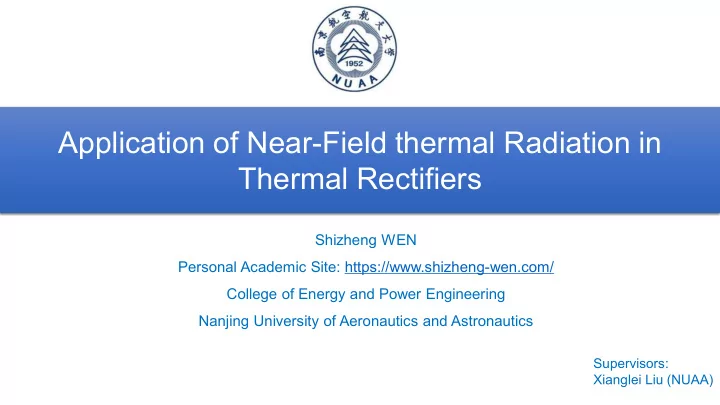

Application of Near-Field thermal Radiation in Thermal Rectifiers Shizheng WEN Personal Academic Site: https://www.shizheng-wen.com/ College of Energy and Power Engineering Nanjing University of Aeronautics and Astronautics Supervisors: Xianglei Liu (NUAA)
Backgrounds Rectification of Electric technology Electric Diode electrons flow Thermal Rectification Thermal Diode Thermal Rectifier Controlling the heat flow may provide alternative ways to process information at harsh conditions
Backgrounds Heat flow can by realized by three approaches: Conduction | Convection | Radiation Forward bias Reverse bias T L T H Q f Q r T H T L Conduction-based Convection-based Radiation-based thermal rectifier thermal rectifier thermal rectifier Chang et al. Science 2006, Avanessian and Hwang, ICNMM2015 Merits : avoid contact Vol. 314, 1121-1124 - 48508 and intrusion
Problem (conduction-based, as high as 100) Forward bias Reverse bias T L T H Q f Q r T H T L Thermal rectification ratio: Q = − f R 1 ratio Q r Avanessian and Hwang, ICNMM2015 - 48508
Method Flat-plate Nanoparticles-based rectifier in my work Calculating Near-field thermal radiation: Ben-Abdallah et al. AIP ADVANCES 5 , ( ) ( ) 1.Two spheres : spectral poynting vector ω × ω 053502 (2015) E r , H r , 1 1 { } ∗ ( ) ( ) ( ) ( ) ( ) ( ) ∫ ∗ ′ ∗ ′ ω ω = ωµ 3 ω ω ω ω E r , H r , i d r G r r , , G r r , , J r , J r , Plate with nanostructures E H ω ω i 1 j 1 0 1 1 l m V ( ) r r ω G 1 , , Dyadic Green’s functions (DGFs) E ( ) r r ω are obtained by using partial-wave G 1 , , H 2. Nanoparticles with irregular shapes: Thermal discrete dipole approximation method (TDDA): The emitter and absorber are discretized into electric dipoles with the number of N e and N a ( ) ω + N N 2 ( ) e a ∗ ∑ − = α 1 2 Q Im k tr R p p Shen et al. JQSRT , Vol. 211, 1-8 (2018) ω i 0 i i 2 3 = + i N 1 e
Method Electrons of silicon will be forward bias reverse bias excited at high temperatures Q f Q r T L T H T H T L dissimilar material dissimilar material intrinsic Si intrinsic Si Electrons will be excited at high Electrons won’t be excited, which temperatures, which gives rise to give rise to the constraint of the enhancement of radiative radiative heat transfer heat transfer High rectification ratio • The temperature-dependent dielectric function of silicon is obtained from Fu and Zhang. Fu et al. International Journal of Heat and Mass Transfer 2006, Vol. 49,1703-1718
Results • Rectification ratios are all above 100 Numbers Material Pairs Numbers Material Pairs 1 Intrinsic Si - Doped Si (10 18 cm -3 ) 6 Doped Si(10 18 cm -3 ) - SiO 2 when intrinsic Si is included in the Doped Si(10 18 cm -3 ) - Au 2 Intrinsic Si - 3C-SiC 7 3 Intrinsic Si - SiO 2 8 3C-SiC - SiO 2 material pair (See number 1 2 3 4). 4 Intrinsic Si - Au 9 3C-SiC - Au 5 Doped Si(10 18 cm -3 ) - 3C-SiC 10 SiO 2 - Au • Rectification ratios are less than 5 when intrinsic Si is not included in the material pair (See number 5 6 7 8 9 10). • A record-high rectification ratio of more than 10 4 is theoretically achieved when the material pair is Near-field radiative heat flux and rectification ratio intrinsic Si and dope Si (10 18 cm -3 ) of the proposed diode for different material pairs
Results Forward bias Reverse bias • In forward biased case, the carrier concentration of intrinsic Si at 1000 K will have nearly the same value as that in doped Si (10 18 cm -3 ) at 300 K. Polarizability of two material will have a strong match • In the reverse biased case, polarizability for doped Si at 1000 K will merely match the peak induced by absorption of lattice vibration for intrinsic Si at 300 K.
Conclusions • A highly efficient radiative thermal rectifier consisting of two nanoparticles, i.e., intrinsic Si nanoparticle and a dissimilar nanoparticle, is proposed. Due to the thermal excitation of intrinsic Si at high temperature, rectification ratios can reach more than 100. • Particularly, for the nanoparticles comprising by intrinsic Si and doped Si (10 18 cm -3 ), the rectification ratio can reach a record-high value of more than 10 4 due to the strong match of polarizability. • Effects of gap distances and configurations of nanoparticles on the rectification ratio can be found in my paper. Shizheng Wen, Xianglei liu, Sheng Cheng, Zhoubing Wang, Shenghao Zhang, Chunzhuo Dang, “Ultrahigh thermal rectification based on near- field thermal radiation between dissimilar nanoparticles”, J. Quant. Spectrosc. Radiat. Transfer 234, 1-9 (2019)
Outline Thank you for listening! Acknowledgement Xianglei Liu Jiadong Shen Yannan Yang Yapeng Hu Hang Yu Yiming Xuan
Recommend
More recommend